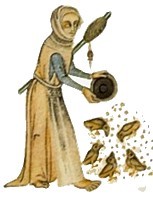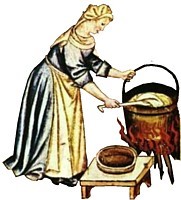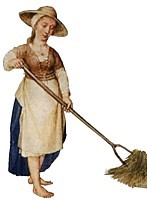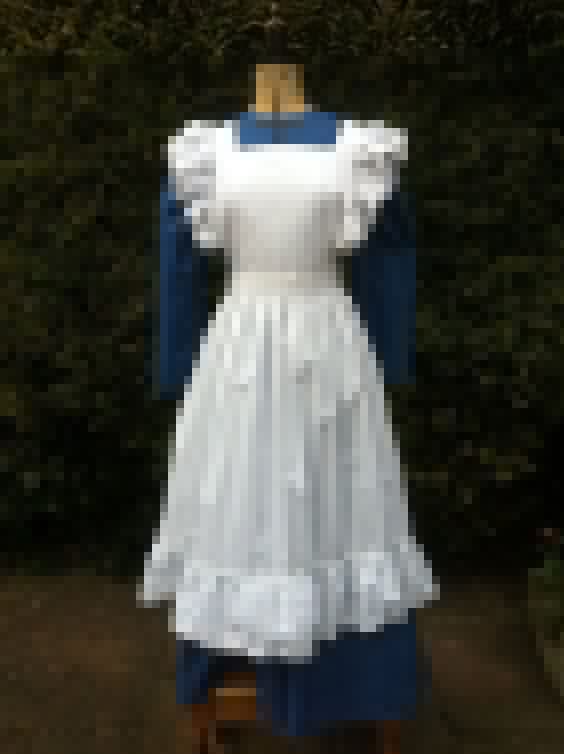Aprons
An apron is a garment that had been worn on the front by men and women, since the ancient times for decorative, ritualistic and practical purposes. The word apron comes from the French word naperon (small tablecloth). Aprons had been worn for protection garments, and were indicating social status. Aprons most commonly were made of cotton, muslin, linen, canvas, leather, rubbed, or lead.
Pages of history
Since the Medieval times all kinds of clothing was exclusive, unique and expensive, and that`s how the aprons became a real way out to continue the work intensively and, at the same time, save your clothing from dirt and dust. Thus, in Middle Ages the apron was mostly associated with the people of crafting professions. Aprons were widely worn by blacksmiths, armor and weapon makers, gardeners, carvers, furniture makers, leather smiths, cobblers, tailors, jewelers, metal forgers, fishmongers, clock makers, home makers, tradesmen, artisans and masons.



Different types of aprons also became symbols of different professions, and often created a so-called nickname to such people. For example, tradesmen were commonly called apron men. English barbers were called checked apron men; butchers had blue stripes on their aprons and stonemasons used to have white aprons. Interestingly, the members of the legendary Masonic lounge have inherited the tradition to wear white aprons, even though most of them never had a job connected with stone crafting or demolition. The proper mason apron uniform was supposed to be long, coming down below the knees, with a flap or bib to protect the chest.
What kinds of aprons exist?
There are also three types of aprons, and the vast majority of aprons are tied at the waist. A half apron that is used for various practical purposes (such as cooking and cleaning) is a small piece of fabric that extends from the waistline to the middle of a thigh. A bib apron, that is also called a full apron, covers the chest and ties at the waist, and is used by patients in the hospital as temporary clothing. A pinafore is a decorative apron that is often worn by young girls as a part of a retro school uniform (such as the famous Soviet one, created by the ensemble of the dark-brown gown and the snow-white apron). Pinafore usually includes decorated ruffles, so-called wings, which are creatively shaped pieces of fabric over the apron`s shoulder. Another type of apron is bungalow apron that is an item of women`s at-home clothing and is used to elaborate a housewives` everyday look, and to prevent them from putting stains on their regular clothes. Most bungalow aprons are simple garments, often decorated with kimono sleeves, and have little trim and almost no fasteners.
The aprons, used for religious service purposes, are called clerical garments. They were mostly a part of a traditional look of the Anglican bishops and archdeacons, and were a short cassock reaching just above the knee and are black of purple in color (depending on the clerical rank).
When the first fashion aprons appeared?
The first aprons that had nothing to do with crafts appeared in the 1500s, when women transformed the apron into a type of an everyday accessory, adjusting it to current trends, decorating it intensively with embroidery and lace. During the times of Oliver Cromwell the Puritan`s look essentially consisted of a white apron covering a log black dress that reached from a woman`s neck to her toes. A white apron was a symbol of women`s intrinsic purity and extrinsic neatness.
In the Victorian times the aprons began to be factory produced and the consumers were able to pick from a range of options. Many aprons were creatively designed with floral and pastoral motifs. Aprons also became among the vital clothing elements of servants in Victorian England. It is an interesting fact that maids in wealthy houses never wore same aprons for different occasions. In the morning most of them were allowed to wear an embroidered dress and a simple casual apron.

However, when serving special occasion parties, they were dressed in a flawlessly black gown with a snow-white apron over it, which created a traditional and elegant, but at the same time, festive and solemn look. The maid`s aprons, in general, were different between the wealthy houses. The maid`s clothing was supposed to represent the employer`s class status and wealth. The wealthiest houses` maids always had exquisite aprons, made of luxurious French lace and white on snow-white embroidery.
But, as mentioned before, wearing an apron was not a sign of being a maid. Wealthy housewives also traditionally wore aprons to show their commitment to family, tidiness and to show their status though beauty of their aprons` design.
The most popular ornament in apron`s design was fig leaf, as worn by Eve in the Garden of Eden. The women of that time nearly fainted when saw this kind of intimate symbol that was, however, an essential element of a fashion design of that times.
Between the early 1900s and the 1950s the apron still maintained the status of a home symbol for women and often appeared in advertisements, related to housework or cooking, including those for irons and kitchen appliances. This kind of a simplified short, above-the-knee elaborate apron became the symbol of the famous American pin-up style.
At the St-Petersburg Global Trade House you will find a great variety of women`s aprons that will satisfy any taste and will create a cozy and traditional atmosphere of a happy and wealthy household.

























